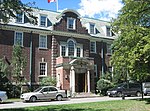Varsity Stadium

Varsity Stadium is an outdoor collegiate football stadium located in Toronto, Ontario, Canada. It is home to the Toronto Varsity Blues, the athletic teams of the University of Toronto. Athletic events have been hosted on the site since 1898; the current stadium was built in 2007 to replace the original permanent stadium built in 1911. Varsity Stadium is also a former home of the Toronto Argonauts, and has previously hosted the Grey Cup, the Vanier Cup, several matches of the 1976 Summer Olympics soccer tournament, and the final game of the North American Soccer League's 1984 Soccer Bowl series (which was also the last game played by the original NASL). It is located next to Varsity Arena.
Excerpt from the Wikipedia article Varsity Stadium (License: CC BY-SA 3.0, Authors, Images).Varsity Stadium
Helga and Mike Schmidt Performace Terrace, Toronto
Geographical coordinates (GPS) Address Website Nearby Places Show on map
Geographical coordinates (GPS)
| Latitude | Longitude |
|---|---|
| N 43.667236 ° | E -79.396294 ° |
Address
University of Toronto (University of Toronto - St. George Campus)
Helga and Mike Schmidt Performace Terrace
M5S 2E5 Toronto
Ontario, Canada
Open on Google Maps







